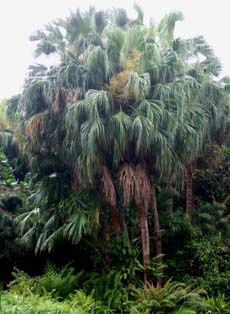Livistona chinensis var. subglobosa Information
A solitary, medium sized, water-loving, salt-tolerant, moderately slow growing, dioecious palm. Common in cultivation, locally common in the wild. It has a rough, grey-brown trunk, 12 m. (40 ft.) tall, 28 cm. (11 inch) diameter with no obvious leaf scars, and huge partially segmented, palmate (fan) leaves, 1.8 m. (6 ft.) long, 1.8 m. (6 ft.) wide, bluish-green above and, pinkish beneath.
This form produces larger fruits and seeds than the Chinese form. The fruits are 2.5 cm. (1 inch) long, ovoid with a beautiful turquoise-blue colouration. The leaf-crown is densely packed with 30 - 50 highly pendulous, bluish green to glossy olive green leaves.
Livistona chinensis var. subglobosa can survive freezing temperatures to about -6.5°C (20.3°F), but freezing is best avoided. This species naturally occurs on islands in moist forest, and is heavily effected by the surrounding sea temperatures, which are constant and often form sea mist and cloud. In this type of natural environment temperature fluctuations are slight, and this palm prefers a constantly mild climate with little temperature difference between day & night, and Summer & Winter. Under extreme freezing conditions we recommend you keep this palm as dry as possible, and well wrapped up.
Identification:
This is a much more attractive form than the usual form of Livistona chinensis found in Southern China, and is also more cold-hardy. Livistona chinensis var. subglobosa is perhaps justifiably not deserved of subspecies status, as the morphological differences are slight when compared with the Chinese mainland form. The main noticeable difference is to be seen in the size and shape of the seeds. The mainland China form, which is the commonest form in cultivation around the world produces a typically elongate, smaller seed (15 - 9 mm) than the Japan/Taiwan form which produces a larger, more globose seed (18 - 12 mm).
General Information:
Livistona chinensis var. subglobosa is naturally distributed from Taiwan through the islands of Okinawa and as far north as Kyushu, Japan, where it grows along shores washed by the warm Kuroshio current. However, due to it's lowland habitat no wild populations exist in Taiwan today. In Japan virgin L. chinensis forest is now found only on the islets of Aoshima and Tsukishima in the Miyazaki prefecture, Kyushu, Japan. The islet of the gods on Aoshima is the extreme northern limit of the species, and this is also officially recognised as the largest single population of the species in Japan consisting of 4000 individuals.
However, I report here, for the first time that by far the largest virgin population of Livistona chinensis var. subglobosa is to be found on a tiny island called Uotsurijima (Japanese) or Diaoyudao (Chinese). This is the largest island of the Senkaku Islands (釣魚台群島 Diàoyútái liè yǔ) or what we know as the Pinnacle Islands. Uotsurijima or Diaoyudao Island located at 25°46′N 123°31′E has an area of 4.3 square kilometres (1.7 sq mi) and a highest elevation of 383 metres (1,260 ft). L. chinensis is the dominant tree species on this island and I estimate this population to be over 100,000 individuals. The Pinnacle Islands are a group of disputed, uninhabited islands currently controlled by Japan, but also claimed by both the Republic of China on Taiwan and the People's Republic of China as part of Taiwan Province. The island group is made up of five small non-volcanic islands which sit on the edge of the continental shelf of mainland China, and are geologically separated from the Ryukyu Islands by the Okinawa Trough. Japan argues that these islets are part of the Ryukyu Islands. They are 170 kilometers (106 mi) north of Ishigaki Island, Japan; 186 km (116 mi) northeast of Keelung, Taiwan; and 410 km (255 mi) west of Okinawa Island. Three domestic goats were deliberately introduced to the island in 1978. There is now an estimated 300+ animals devastating the juvenile palm population, and this last true stronghold of this palm is seriously threatened.
Distribution:
Native to, Japan, Taiwan
Taiwan and the Ryukyu archipelago of Japan as far north as Aoshima Island, Japan. It is also known to have occurred on Tsushima island (at latitude 34°N) located to the south of the Korean Peninsula.
Location: Taiwan, Japan (25.745478°N, 123.472595°E)

